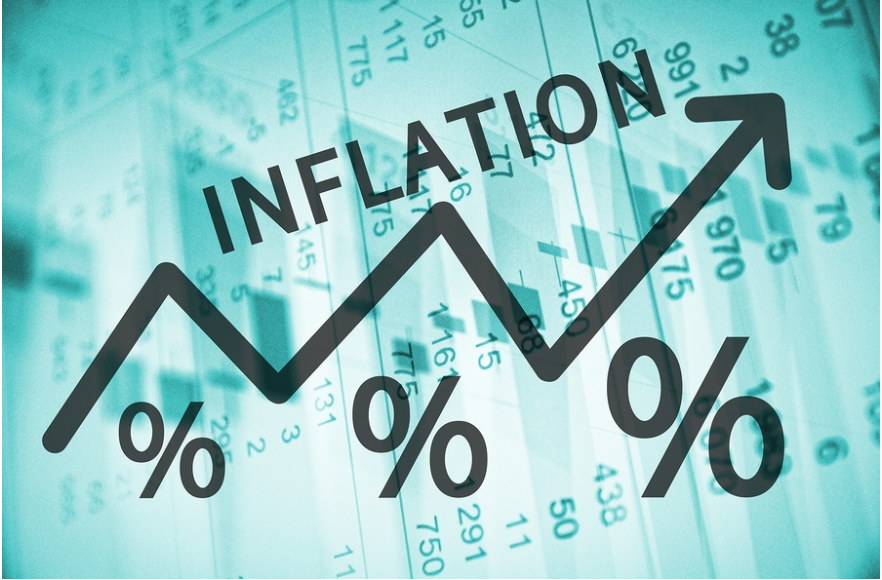Fra bls.gov
Consumer Price Index Summary
Transmission of material in this release is embargoed until 8:30 a.m. (ET) Wednesday, May 10, 2023 USDL-23-0942 Technical information: (202) 691-7000 * [email protected] * www.bls.gov/cpi Media contact: (202) 691-5902 * [email protected] CONSUMER PRICE INDEX - APRIL 2023 The Consumer Price Index for All Urban Consumers (CPI-U) rose 0.4 percent in April on a seasonally adjusted basis, after increasing 0.1 percent in March, the U.S. Bureau of Labor Statistics reported today. Over the last 12 months, the all items index increased 4.9 percent before seasonal adjustment. The index for shelter was the largest contributor to the monthly all items increase, followed by increases in the index for used cars and trucks and the index for gasoline. The increase in the gasoline index more than offset declines in other energy component indexes, and the energy index rose 0.6 percent in April. The food index was unchanged in April, as it was in March. The index for food at home fell 0.2 percent over the month while the index for food away from home rose 0.4 percent. The index for all items less food and energy rose 0.4 percent in April, as it did in March. Indexes which increased in April include shelter, used cars and trucks, motor vehicle insurance, recreation, household furnishings and operations, and personal care. The index for airline fares and the index for new vehicles were among those that decreased over the month. The all items index increased 4.9 percent for the 12 months ending April; this was the smallest 12-month increase since the period ending April 2021. The all items less food and energy index rose 5.5 percent over the last 12 months. The energy index decreased 5.1 percent for the 12 months ending April, and the food index increased 7.7 percent over the last year.
| Seasonally adjusted changes from preceding month | Un- adjusted 12-mos. ended Apr. 2023 | |||||||
|---|---|---|---|---|---|---|---|---|
| Oct. 2022 | Nov. 2022 | Dec. 2022 | Jan. 2023 | Feb. 2023 | Mar. 2023 | Apr. 2023 | ||
All items | 0.5 | 0.2 | 0.1 | 0.5 | 0.4 | 0.1 | 0.4 | 4.9 |
Food | 0.7 | 0.6 | 0.4 | 0.5 | 0.4 | 0.0 | 0.0 | 7.7 |
Food at home | 0.5 | 0.6 | 0.5 | 0.4 | 0.3 | -0.3 | -0.2 | 7.1 |
Food away from home(1) | 0.9 | 0.5 | 0.4 | 0.6 | 0.6 | 0.6 | 0.4 | 8.6 |
Energy | 1.7 | -1.4 | -3.1 | 2.0 | -0.6 | -3.5 | 0.6 | -5.1 |
Energy commodities | 3.7 | -2.1 | -7.2 | 1.9 | 0.5 | -4.6 | 2.7 | -12.6 |
Gasoline (all types) | 3.4 | -2.3 | -7.0 | 2.4 | 1.0 | -4.6 | 3.0 | -12.2 |
Fuel oil(1) | 19.8 | 1.7 | -16.6 | -1.2 | -7.9 | -4.0 | -4.5 | -20.2 |
Energy services | -0.7 | -0.6 | 1.9 | 2.1 | -1.7 | -2.3 | -1.7 | 5.9 |
Electricity | 0.5 | 0.5 | 1.3 | 0.5 | 0.5 | -0.7 | -0.7 | 8.4 |
Utility (piped) gas service | -3.7 | -3.4 | 3.5 | 6.7 | -8.0 | -7.1 | -4.9 | -2.1 |
All items less food and energy | 0.3 | 0.3 | 0.4 | 0.4 | 0.5 | 0.4 | 0.4 | 5.5 |
Commodities less food and energy commodities | -0.1 | -0.2 | -0.1 | 0.1 | 0.0 | 0.2 | 0.6 | 2.0 |
New vehicles | 0.6 | 0.5 | 0.6 | 0.2 | 0.2 | 0.4 | -0.2 | 5.4 |
Used cars and trucks | -1.7 | -2.0 | -2.0 | -1.9 | -2.8 | -0.9 | 4.4 | -6.6 |
Apparel | -0.2 | 0.1 | 0.2 | 0.8 | 0.8 | 0.3 | 0.3 | 3.6 |
Medical care commodities(1) | 0.0 | 0.2 | 0.1 | 1.1 | 0.1 | 0.6 | 0.5 | 4.0 |
Services less energy services | 0.5 | 0.5 | 0.6 | 0.5 | 0.6 | 0.4 | 0.4 | 6.8 |
Shelter | 0.7 | 0.6 | 0.8 | 0.7 | 0.8 | 0.6 | 0.4 | 8.1 |
Transportation services | 0.6 | 0.3 | 0.6 | 0.9 | 1.1 | 1.4 | -0.2 | 11.0 |
Medical care services | -0.4 | -0.5 | 0.3 | -0.7 | -0.7 | -0.5 | -0.1 | 0.4 |
Food
The food index was unchanged in April. The food at home index fell 0.2 percent over the month, following a
0.3-percent decrease in March. Four of the six major grocery store food group indexes decreased over the month
. The index for fruits and vegetables decreased 0.5 percent in April, and the index for meats, poultry, fish,
and eggs declined 0.3 percent over the month. The dairy and related products index decreased 0.7 percent in
April as the milk index fell 2.0 percent, the largest decline in that index since February 2015. The
nonalcoholic beverages index declined 0.1 percent over the month.
In contrast, the index for other food at home rose 0.2 percent in April, following a 0.4-percent increase the
previous month. The cereals and bakery products index increased 0.2 percent over the month, after advancing
0.6 percent in March.
The food away from home index rose 0.4 percent in April. The index for full service meals increased 0.1
percent over the month and the index for limited service meals increased 0.6 percent.
The food at home index rose 7.1 percent over the last 12 months. The index for cereals and bakery products
rose 12.4 percent over the 12 months ending in April. The remaining major grocery store food groups posted
increases ranging from 2.0 percent (fruits and vegetables) to 10.4 percent (other food at home).
The index for food away from home rose 8.6 percent over the last year. The index for full service meals rose
7.2 percent over the last 12 months, and the index for limited service meals rose 8.2 percent over the same
period.
Energy
The energy index rose 0.6 percent in April after decreasing 3.5 percent in March. The gasoline index increased
3.0 percent in April, following a 4.6-percent decrease in the previous month. (Before seasonal adjustment,
gasoline prices rose 5.2 percent in April.)
Other energy components declined, as the natural gas index decreased 4.9 percent over the month, the third
consecutive decrease in that index. The index for electricity decreased 0.7 percent in April, as it did in
March. The fuel oil index also declined in April, down 4.5 percent.
The energy index fell 5.1 percent over the past 12 months. The gasoline index decreased 12.2 percent over the
last 12 months, while the natural gas index fell 2.1 percent, and the fuel oil index fell 20.2 percent over
the span. In contrast, the index for electricity rose 8.4 percent over the last year.
All items less food and energy
The index for all items less food and energy rose 0.4 percent in April, as it did in March. The shelter index
increased 0.4 percent over the month after rising 0.6 percent in March. The index for rent rose 0.6 percent
in April, and the index for owners' equivalent rent rose 0.5 percent over the month. The index for lodging
away from home decreased 3.0 percent in April after rising in each of the previous four months.
The shelter index was the largest factor in the monthly increase in the index for all items less food and
energy. Among the other indexes that rose in April was the index for used cars and trucks, which increased
4.4 percent, and the index for motor vehicle insurance which increased 1.4 percent. The indexes for recreation,
household furnishings and operations, personal care, apparel, and education also increased in April.
Several indexes declined in April, led by the airline fares index which fell 2.6 percent over the month after
rising in February and March. The index for new vehicles declined 0.2 percent and the index for communication
decreased 0.1 percent in April.
The medical care index was unchanged in April, after falling 0.3 percent the previous month. The index for
hospital services rose 0.5 percent over the month, after a 0.4-percent decline in March. The prescription
drugs index increased 0.3 percent in April, while the physicians' services index was unchanged.
The index for all items less food and energy rose 5.5 percent over the past 12 months. The shelter index
increased 8.1 percent over the last year, accounting for over 60 percent of the total increase in all items
less food and energy. Other indexes with notable increases over the last year include motor vehicle insurance
(+15.5 percent), household furnishings and operations (+5.3 percent), recreation (+5.0 percent), and new
vehicles (+5.4 percent).
Not seasonally adjusted CPI measures
The Consumer Price Index for All Urban Consumers (CPI-U) increased 4.9 percent over the last 12 months to an
index level of 303.363 (1982-84=100). For the month, the index increased 0.5 percent prior to seasonal
adjustment.
The Consumer Price Index for Urban Wage Earners and Clerical Workers (CPI-W) increased 4.6 percent over the
last 12 months to an index level of 297.730 (1982-84=100). For the month, the index increased 0.6 percent
prior to seasonal adjustment.
The Chained Consumer Price Index for All Urban Consumers (C-CPI-U) increased 5.2 percent over the last 12
months. For the month, the index increased 0.5 percent on a not seasonally adjusted basis. Please note that
the indexes for the past 10 to 12 months are subject to revision.
_______________
The Consumer Price Index for May 2023 is scheduled to be released on Tuesday, June 13, 2023, at 8:30 a.m. (ET).
Technical Note
Brief Explanation of the CPI
The Consumer Price Index (CPI) measures the change in prices paid by consumers for goods and services.
The CPI reflects spending patterns for each of two population groups: all urban consumers and urban
wage earners and clerical workers. The all urban consumer group represents over 90 percent of the
total U.S. population. It is based on the expenditures of almost all residents of urban or
metropolitan areas, including professionals, the self-employed, the poor, the unemployed, and retired
people, as well as urban wage earners and clerical workers. Not included in the CPI are the spending
patterns of people living in rural nonmetropolitan areas, farming families, people in the Armed Forces,
and those in institutions, such as prisons and mental hospitals. Consumer inflation for all urban
consumers is measured by two indexes, namely, the Consumer Price Index for All Urban Consumers (CPI-U)
and the Chained Consumer Price Index for All Urban Consumers (C-CPI-U).
The Consumer Price Index for Urban Wage Earners and Clerical Workers (CPI-W) is based on the
expenditures of households included in the CPI-U definition that meet two requirements: more than
one-half of the household's income must come from clerical or wage occupations, and at least one of
the household's earners must have been employed for at least 37 weeks during the previous 12 months.
The CPI-W population represents approximately 30 percent of the total U.S. population and is a subset
of the CPI-U population.
The CPIs are based on prices of food, clothing, shelter, fuels, transportation, doctors' and dentists'
services, drugs, and other goods and services that people buy for day-to-day living. Prices are
collected each month in 75 urban areas across the country from about 6,000 housing units and
approximately 22,000 retail establishments (department stores, supermarkets, hospitals, filling
stations, and other types of stores and service establishments). All taxes directly associated with
the purchase and use of items are included in the index. Prices of fuels and a few other items are
obtained every month in all 75 locations. Prices of most other commodities and services are collected
every month in the three largest geographic areas and every other month in other areas. Prices of most
goods and services are obtained by personal visit, telephone call, or web collection by the Bureau�s
trained representatives.
In calculating the index, price changes for the various items in each location are aggregated using
weights, which represent their importance in the spending of the appropriate population group. Local
data are then combined to obtain a U.S. city average. For the CPI-U and CPI-W, separate indexes are
also published by size of city, by region of the country, for cross-classifications of regions and
population-size classes, and for 23 selected local areas. Area indexes do not measure differences in
the level of prices among cities; they only measure the average change in prices for each area since
the base period. For the C-CPI-U, data are issued only at the national level. The CPI-U and CPI-W are
considered final when released, but the C-CPI-U is issued in preliminary form and subject to three
subsequent quarterly revisions.
The index measures price change from a designed reference date. For most of the CPI-U and the CPI-W,
the reference base is 1982-84 equals 100. The reference base for the C-CPI-U is December 1999 equals
100. An increase of 7 percent from the reference base, for example, is shown as 107.000. Alternatively,
that relationship can also be expressed as the price of a base period market basket of goods and
services rising from $100 to $107.
Sampling Error in the CPI
The CPI is a statistical estimate that is subject to sampling error because it is based upon a sample
of retail prices and not the complete universe of all prices. BLS calculates and publishes estimates
of the 1-month, 2-month, 6-month, and 12-month percent change standard errors annually for the CPI-U.
These standard error estimates can be used to construct confidence intervals for hypothesis testing.
For example, the estimated standard error of the 1-month percent change is 0.03 percent for the U.S.
all items CPI. This means that if we repeatedly sample from the universe of all retail prices using
the same methodology, and estimate a percentage change for each sample, then 95 percent of these
estimates will be within 0.06 percent of the 1-month percentage change based on all retail prices.
For example, for a 1-month change of 0.2 percent in the all items CPI-U, we are 95 percent confident
that the actual percent change based on all retail prices would fall between 0.14 and 0.26 percent.
For the latest data, including information on how to use the estimates of standard error, see
www.bls.gov/cpi/tables/variance-estimates/home.htm.
Calculating Index Changes
Movements of the indexes from 1 month to another are usually expressed as percent changes rather than
changes in index points, because index point changes are affected by the level of the index in
relation to its base period, while percent changes are not. The following table shows an example of
using index values to calculate percent changes:
Item A Item B Item C
Year I 112.500 225.000 110.000
Year II 121.500 243.000 128.000
Change in index points 9.000 18.000 18.000
Percent change 9.0/112.500 x 100 = 8.0 18.0/225.000 x 100 = 8.0 18.0/110.000 x 100 = 16.4
Use of Seasonally Adjusted and Unadjusted Data
The Consumer Price Index (CPI) program produces both unadjusted and seasonally adjusted data.
Seasonally adjusted data are computed using seasonal factors derived by the X-13ARIMA-SEATS seasonal
adjustment method. These factors are updated each February, and the new factors are used to revise the
previous 5 years of seasonally adjusted data. The factors are available at
www.bls.gov/cpi/tables/seasonal-adjustment/seasonal-factors-2023.xlsx.
For more information on data revision scheduling, please see the Factsheet on Seasonal Adjustment at
www.bls.gov/cpi/seasonal-adjustment/questions-and-answers.htm
and the Timeline of Seasonal Adjustment Methodological Changes at
www.bls.gov/cpi/seasonal-adjustment/timeline-seasonal-adjustment-methodology-changes.htm.
How to Use Seasonally Adjusted and Unadjusted Data
For analyzing short-term price trends in the economy, seasonally adjusted changes are usually preferred
since they eliminate the effect of changes that normally occur at the same time and in about the same
magnitude every year�such as price movements resulting from weather events, production cycles, model
changeovers, holidays, and sales. This allows data users to focus on changes that are not typical for
the time of year.
The unadjusted data are of primary interest to consumers concerned about the prices they actually pay.
Unadjusted data are also used extensively for escalation purposes. Many collective bargaining contract
agreements and pension plans, for example, tie compensation changes to the Consumer Price Index before
adjustment for seasonal variation. BLS advises against the use of seasonally adjusted data in
escalation agreements because seasonally adjusted series are revised annually.






